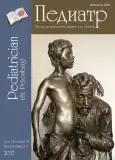Hemodynamic Patterns Determined By Non-Invasive Cw-Doppler Ultrasound Cardiac Monitoring (USCOM) in Preterm Neonates with Respiratory Distress Syndrome During Non-Invasive Respiratory Support
- 作者: Sergeeva V.A.1, Alexandrovich Y.S.2, Strelkov D.M.3, Siniuk K.A.1
-
隶属关系:
- Kursk State Medical University
- St Petersburg State Pediatric Medical University
- Kursk Regional Perinatal Centre
- 期: 卷 8, 编号 3 (2017)
- 页面: 41-46
- 栏目: Articles
- URL: https://journals.rcsi.science/pediatr/article/view/6695
- DOI: https://doi.org/10.17816/PED8341-46
- ID: 6695
如何引用文章
详细
Aim: To determine the hemodynamic patterns in preterm neonates with respiratory distress syndrome (RDS) using the USCOM-1A technology.
Materials and Methods: The USCOM device is a bedside method of evaluating cardiac output (CO) based on continuous-wave Doppler ultrasound. Hemodynamic parameters were measured daily for 7 days in 32 preterm neonates 32 ± 1 weeks of gestation (1688 ± 111 g) with RDS requiring noninvasive respiratory support (NCPAP, NIPPV, HFNC) and no catecholamine support in comparison with 28 healthy term neonates (3100 ± 690 g).
Results: At day 1, preterm neonates had lower SVI (18 ± 5 vs 28 ± 8 ml m−2, p = 0.043) and higher SVRI (1585 ± 245 vs 1035 ± 358 dyn s cm−5 m2, p = 0.013) with a tendency for lower cardiac index (2.6 ± 0.8 vs 4.0 ± 1.3 l min−1 m−2, p = 0.089). Together with no difference in SMII, it indicates the presence of diastolic dysfunction with low preload. It is noted that all parameters had not changed by day 7 in preterm neonates, whereas term neonates demonstrated significantly increased SMII reflecting postnatal cardiovascular adaptation. Compared with preterm neonates with RDS requiring NCPAP/NIPPV, preterm neonates requiring HFNC had higher levels of FTc (330 ± 59 vs 388 ± 41 ms, р = 0.045), SVI (13 ± 3 vs 18 ± 4, ml/m2, р = 0.007), SMII (0.41 ± 0.09 vs 0.57 ± 0.21, р = 0.02), and CI (2.2 ± 0.6 vs 4.5 ± 0.9 l/min/m2, р = 0.006).
Conclusions:Noninvasive respiratory support in preterm neonates with RDS may lead to diastolic dysfunction that is less prominent in neonates with HFNC.
作者简介
Vera Sergeeva
Kursk State Medical University
编辑信件的主要联系方式.
Email: verasergeeva1973@icloud.com
MD, PhD, Dr Med Sci, Professor, Department of Anesthesiology and Intensive Care Faculty of Postgraduate Education
俄罗斯联邦, KurskYuri Alexandrovich
St Petersburg State Pediatric Medical University
Email: Jalex1963@mail.ru
MD, PhD, Dr Med Sci, Professor, Head. Department of Anesthesiology and Intensive Care and Emergency Pediatrics Faculty of Postgraduate Education
俄罗斯联邦, Saint PetersburgDenis Strelkov
Kursk Regional Perinatal Centre
Email: denistrel@yandex.ru
MD, neonatologist. Neonatology Department
俄罗斯联邦, KurskKseniya Siniuk
Kursk State Medical University
Email: siniuk@yandex.ru
Resident, Department of Anesthesiology and Intensive Care Faculty of Postgraduate Education
俄罗斯联邦, Kursk参考
- Aleksandrovich YuS, Pshenisnov KV, Chijenas V. Modern concepts of noninvasive respiratory support in neonatology. 2015. Baden-Baden Deutscher Wissenschafts-Verlag (DWV). 67 p.
- Cassidy S, Mitchell JH, Johnson RL. Dimensional analysis of right and left ventricles during positive-pressure ventilation in dogs. Am J Physiol. 1982;242:549-556.
- Munoz R, et al. Critical Care of children with heart disease. Springer, 2010. P. 33-36.
- Fessler HE, Brower RG, Shapiro EP, Permutt S. Effects of positive end-expiratory pressure and body position on pressure in the thoracic great veins. Am Rev Respir Dis. 1993;148:1657-1664. doi: 10.1164/ajrccm/148.6_Pt_1.1657.
- Fuhrman BP, Smith-Wright DL, Venkataraman S, Howland DF. Pulmonary vascular resistance after cessation of positive endexpiratory pressure. J Appl Physiol. 1989;66:660-668.
- Giles N. Cattermole, Mia Leung PY, Paulina SK, et al. The normal ranges of cardiovascular parameters in children measured using the Ultrasonic Cardiac Output Monitor. Crit Care Med. 2010;38(9):1875-1881. doi: 10.1097/CCM.0b013e3181e8adee.
- He Shao-ru, Zhang Cheng, Liu Yu-mei, et al. Accuracy of the ultrasonic cardiac output monitor in healthy term neonates during postnatal circulatory adaptation. Chin Med J. 2011;124(15):2284-2289.
- Venkataraman ST, Fuhrman BP, Howland DF, DeFrancisis M. Positive end-expiratory pressure-induced, calcium-channel mediated increases in pulmonary vascular resistance in neonatal lambs. Crit Care Med. 1993;21:1066-1076. doi: 10.1097/00003246-199307000-00025.
补充文件







